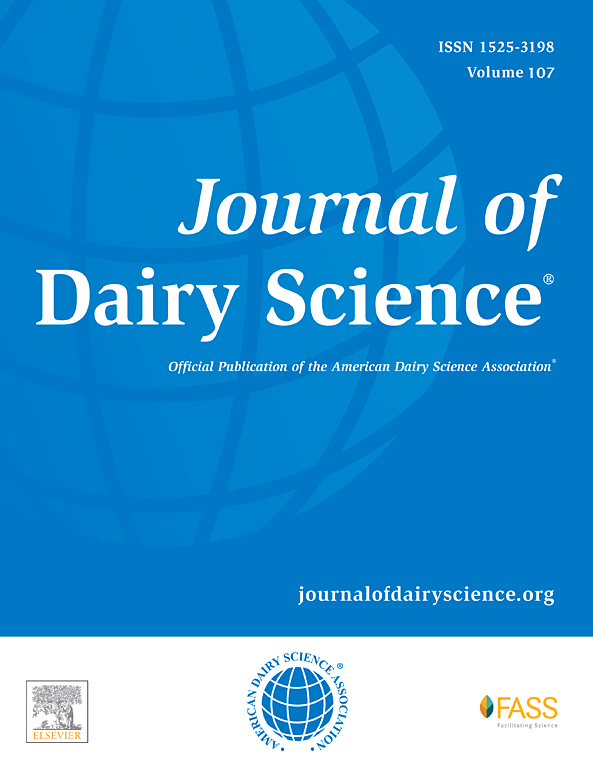水牛奶品质:季节对成分和体细胞数影响的研究。
IF 4.4
1区 农林科学
Q1 AGRICULTURE, DAIRY & ANIMAL SCIENCE
引用次数: 0
摘要
尽管水牛奶在世界范围内是一种重要的食品,但人们对影响巴西水牛奶农场水牛奶质量的因素知之甚少。它在牛奶总产量上排名第二,牛奶排名第一,但缺乏水牛奶的最低法律参数是一些国家面临的另一个问题,就像巴西一样,尽管巴西的水牛群是拉丁美洲最大的水牛群之一,拥有成功的乳制品加工链,但水牛种群只占奶牛总数的不到1%。本研究调查了巴西米纳斯吉拉斯州高海拔热带地区产的水牛奶的成分和体细胞计数(SCC),该地区的水牛在2月至5月自然产犊。使用傅里叶变换红外光谱(Fourier Transform Infrared-FTIR)和流式细胞术(流式细胞术)分析了2211份原料奶样品的组成参数(脂肪、蛋白质、乳糖、总固体和非脂肪固体)。还收集了官方气候数据。采用描述性统计、多元统计和主成分分析(PCA)。脂肪、蛋白质、非脂肪固形物和总固形物浓度在夏季和春季最高,脂肪为6.01和6.31g/100g,蛋白质为4.23和4.18g/100g, SNF为9.93和9.92g/100g, TS为15.95和16.23g/100g。同一季节乳糖的浓度最低,分别为4.76 g/100g和4.75g/100g。与SCC相关性最高的成分是乳糖,春季SCC值最高,与秋季SCC值相似。水牛奶中各成分的浓度受季节的影响,与牛奶相反。然而,在同一地区,水牛奶的SCC通常低于牛奶报告的计数。未来的研究必须包括数据和加权平均值,以估计这一年中这种波动的财务影响和牛奶质量支付。本文章由计算机程序翻译,如有差异,请以英文原文为准。
Buffalo milk quality: A study of seasonal influence on composition and somatic cell count
Despite buffalo milk being an important food worldwide, not much is known about factors that influence its quality on Brazilian buffalo milk farms. It ranks second in total volume of milk production, with cow milk in first place, but a lack of minimum legal parameters for buffalo milk is another problem faced by some countries as it happens in Brazil, where the buffalo population represents less than 1% of dairy cows, even though the Brazilian buffalo herd is one of the largest in Latin America, with a successful dairy processing chain. This study investigated the composition and SCC of buffalo milk produced in a high-altitude tropical region in the state of Minas Gerais, Brazil, where buffalo calving naturally happens from February to May. A total of 2,211 samples of raw milk were analyzed for compositional parameters (fat, protein, lactose, TS, and SNF) using Fourier-transform infrared spectra and for SCC using flow cytometry. Official climatological data were also collected. Descriptive, multivariate statistics and principal component analysis were used. The highest fat, protein, solids nonfat, and total solids concentrations were recorded during the summer and spring seasons, 6.01 and 6.31 g/100 g for fat, 4.23 and 4.18 g/100 g for protein, 9.93 and 9.92 g/100 g for SNF, and 15.95 and 16.23 g/100 g for TS, respectively. Lactose, however, had the lowest concentration observed in the same seasons, 4.76 and 4.75 g/100 g, respectively. The component with the highest correlation to SCC was lactose, with the highest SCC values during spring, which was similar to the SCC during the fall. The concentrations of buffalo milk components were influenced by the season, with an opposite trend when compared with cow milk. However, buffalo milk SCC was usually lower than the counts reported for cow milk in the same region. Upcoming studies must include data as well as weighted averages to estimate the financial effect of this oscillation during the year and for milk quality payment.
求助全文
通过发布文献求助,成功后即可免费获取论文全文。
去求助
来源期刊

Journal of Dairy Science
农林科学-奶制品与动物科学
CiteScore
7.90
自引率
17.10%
发文量
784
审稿时长
4.2 months
期刊介绍:
The official journal of the American Dairy Science Association®, Journal of Dairy Science® (JDS) is the leading peer-reviewed general dairy research journal in the world. JDS readers represent education, industry, and government agencies in more than 70 countries with interests in biochemistry, breeding, economics, engineering, environment, food science, genetics, microbiology, nutrition, pathology, physiology, processing, public health, quality assurance, and sanitation.
 求助内容:
求助内容: 应助结果提醒方式:
应助结果提醒方式:


